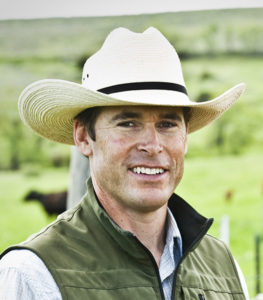By Holly Stoltz
That sounds like the start of a bad joke, don’t you think?
Don’t walk under a ladder; watch out for black cats…Blah, blah, blah. It is Friday the 13th, after all.
But did you know, in all actuality, the number 13 isn’t all doom and gloom? In numerology, 13 is the composition of focus, pragmatism, independence, creativity in self-expression, and building a secure future.
Knowing this realization, it sounds like 13 is the perfect number for a regenerative mindset! It requires focus to plan grazing, enterprises, and goal setting; it is a practical way to solve problems; it requires independent and creative approaches; and it helps to build a secure future.
So today, instead of being superstitious about what bad may happen, let’s focus on setting some positive and achievable goals for 2023.
1-Perform a cost comparison between at least two enterprises you are considering adding to your operation or currently have. To help with this, listen to the November (Tris Munsick) and December (Jordan Steele – Ranching for Profit) Bull Session recordings that can be found on our website. Several free tools are mentioned, and if you need further assistance, reach out to me – I have even more!
2-Sign up for a Winter Grazing tour with Cooper Hibbard. Typically he schedules four dates to give people options, now through April. These are absolutely incredible and very insightful. If he can graze all winter long in the hills behind Cascade, Montana, you can graze anywhere!
3-Since winter is a great time to network, plan to attend the Soil Symposium in Billings on Feb. 9-10. This is an excellent opportunity to connect with fellow ranchers and learn from a variety of experts.
4-If you are just starting out in regenerative practices or need a report on your progress in the eight key management areas, take our free Regen Ranch Guide. It will take you about 20 minutes to complete, and at the end, you will not only learn more about what it means to be regenerative but also where you can make improvements – where that low-hanging fruit may be.
5-If there was one lesson I learned last year, it was to focus your attention on the low-hanging fruit. By that, I mean pick an area on your ranch with good growth potential and perform an intensive grazing rotation. If that is the only chance you get to try rotational grazing, this is how to do it. You will see quicker results that will prove to you that it works and get you excited to try it on a larger scale.
6-Make contact with at least one person outside your “circle” and ask for their advice. As many producers have experienced, this journey cannot be taken alone. And you will be amazed at how open, honest, and willing to share these folks can be.
7-This spring, participate in the SOIL YOUR UNDIES challenge! Buy a couple of pairs of tighty whities (100% cotton) and bury them in two separate locations. For a good comparison, bury one pair in what you would consider a healthy soil location and the other in a less desirable spot. Keep them buried for at least six weeks. Take before and after photos! This is an easy way to monitor the living activity in your soil.
8- Try resting a portion of a pasture for one year. Don’t make this more complicated than it has to be. Pick a corner or easily fenced-out area that was grazed last year and run an electric fence. If we have a moisture-filled spring, consider resting a larger area. Once again, take before and after photographs.
9-Here’s one that I am excited to try. As many of us know, we tend to get in a hurry; there’s always something else that needs to be done. But this summer, take a couple of hours out of your season to observe. When you move your animals, grab a lawn chair and sit for an hour instead of leaving directly after the fencing is done. Document what you see, hear, and smell. How many different birds did you see or hear? What does the grass look like? How fat and sassy are the animals – write down a body score. What insects are buzzing around? There’s so much we can learn by just observing. Do this at least once a month.
10-Grab a mediocre grass bale and drop it on a bare spot, cut the strings, and let the animals go to town. Once again, take a picture of what the ground looked like before and then revisit the site later in the growing season to see what has changed. Don’t be alarmed if there are lots of weeds. We have to remember that weeds are the first signs of healing!
11-How about dabbling in the direct-to-consumer market? Instead of sending a cull animal – something you know you’ll lose money on – to the sale ring, try butchering it and selling the burger to community members. If you’re going through a non-USDA certified processor, technically, the right way to do this is pre-sell the live animal, which shouldn’t be hard to do – no one can have enough burger! If the plant is USDA-certified, then you should be good to go. But don’t take my word for it; it’s best to check with your processor beforehand.
12- Explore market opportunities at the 2nd Annual Expanding Livestock Markets Conference (dates and times TBD). Learn what the future holds for regeneratively raised products and how you can benefit from changing your management practices. The momentum is getting stronger for regeneratively sourced products. Make sure you are the one who reaps the rewards!
13-Perform a forage budget on at least one pasture. The easiest way to do this is to take a piece of bendable material 4 feet long and make a circle out of it – I tried to find a hula hoop that size but to no avail. Randomly throw the ring out, cut all the grass in the circle, bag it, dry it, and weigh it. I bought an inexpensive scale that weighs in pounds, ounces, and grams. For this, use the grams. Multiply this number by 20, and you get the amount of grass per acre. Do this in several locations to get more accurate readings. After you get your amounts, reference the document for the nutritional needs of each class of livestock in the resource library on the Rancher Network (search by topic: livestock)
Start Small!
Remember, don’t get bogged down in the details. Regenerative is about making positive change – change being the operative word. It’s okay to fail; you learn way more from failing than you do from succeeding. And don’t try to take on too much. Pull a handful you know you can accomplish if this list seems overwhelming. But I can’t stress this enough, document, document, document. Take pictures and write notes. You will be glad you did!
Now get out there and enjoy this 13th day of January!
























